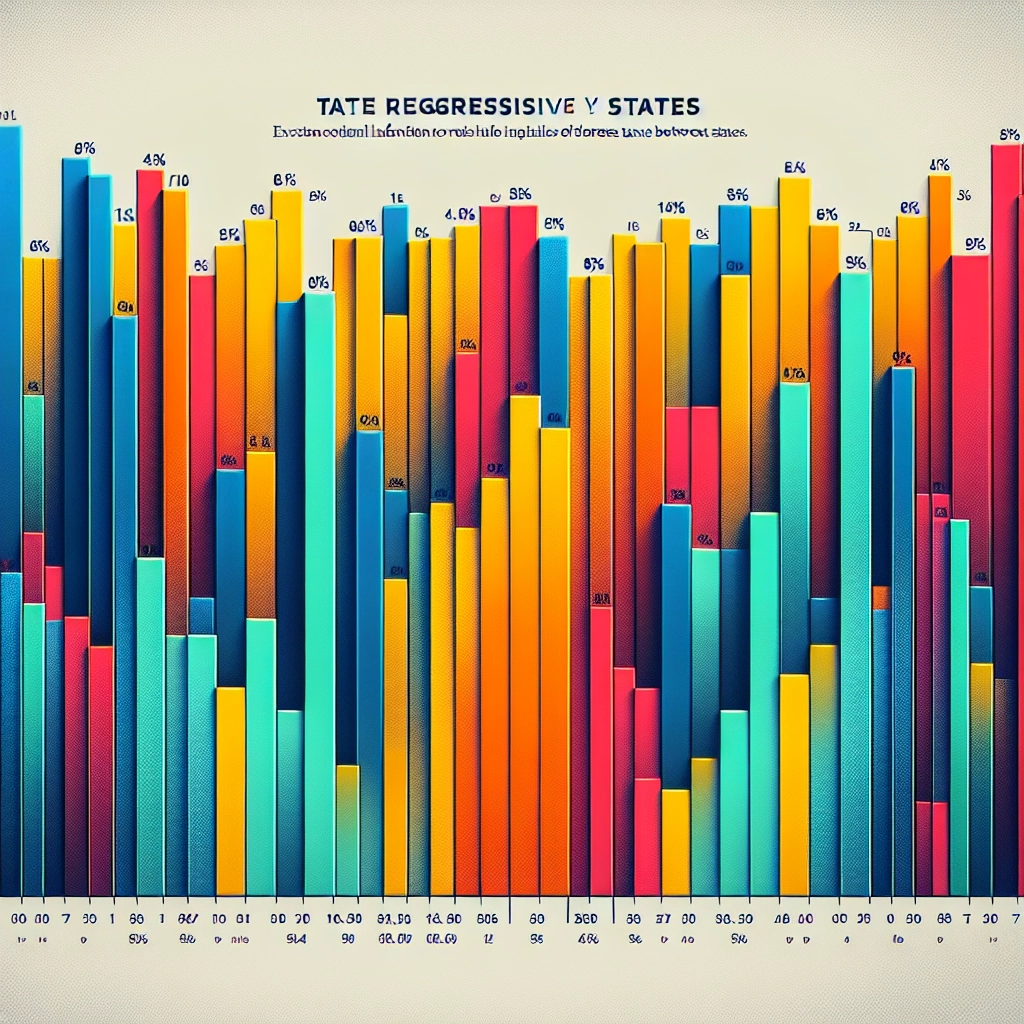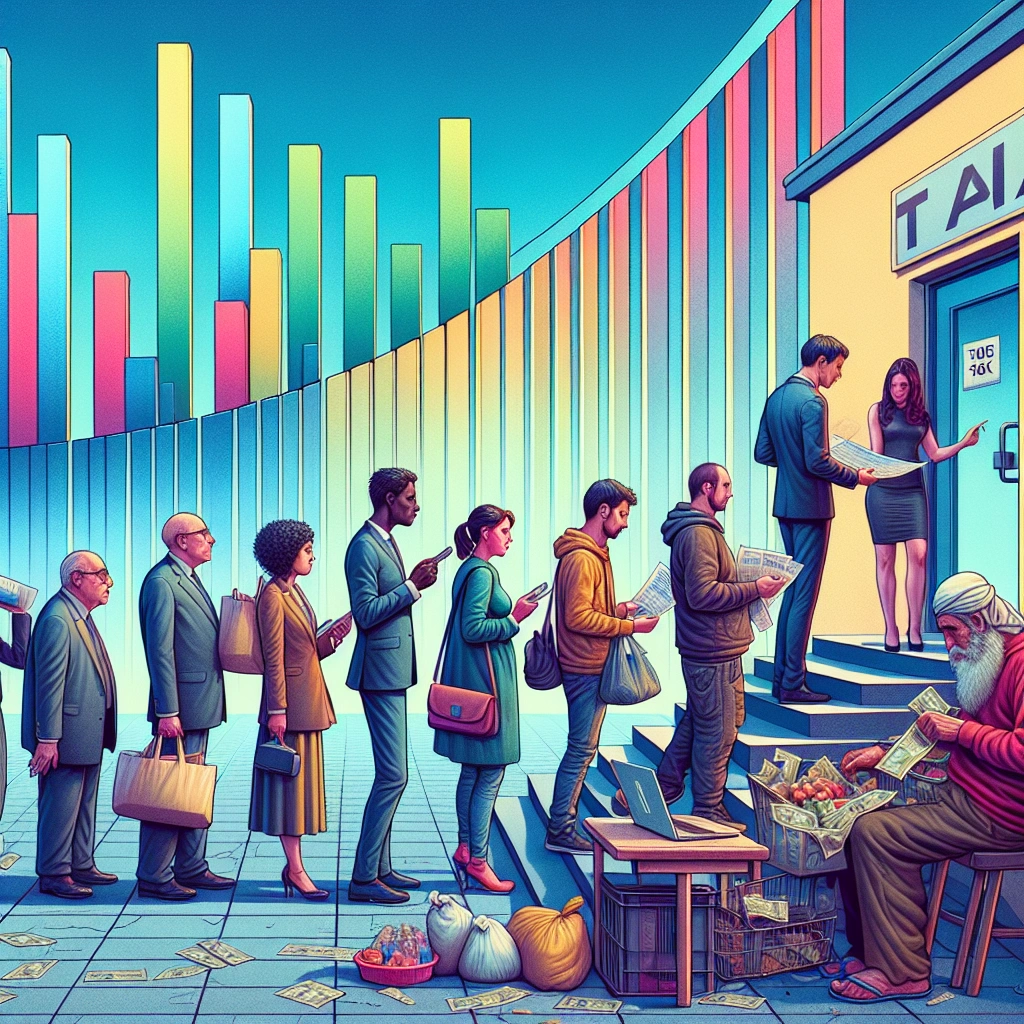Most Regressive Tax States: A Comparative Analysis


Regressive tax is a type of tax where the average tax burden decreases with income. Low-income taxpayers pay a larger share of the tax burden, while middle- and high-income taxpayers pay less.
The purpose of this article is to explore the most regressive tax states in the United States.
Regressive taxes create a disproportionate burden on low-income households, leading to income inequality and reduced social mobility. The main criticism of regressive tax systems is the harsher impact on lower-income households compared to higher-income households.
This article aims to highlight the states with the most regressive tax systems and their impact on different income groups.
By focusing on the most regressive tax states, this article aims to shed light on the potential challenges faced by low-income families and the implications of regressive tax systems on income distribution. The analysis will provide insight into the impact of regressive taxes on various income groups and contribute to the ongoing discourse on tax reform and income inequality in the United States.
Understanding Regressive Tax
Definition of regressive tax
A regressive tax is a type of tax where the average tax burden decreases with income. This means that low-income individuals bear a disproportionate share of the tax burden, while high-income earners shoulder a relatively smaller tax burden.
It is often characterized by a flat tax nature, where the same rate of tax applies regardless of income. Examples of regressive taxes include sales taxes, payroll taxes, excise taxes, and property taxes.
Examples of regressive tax systems
Common forms of regressive taxes include sales tax, gas tax, and payroll tax. These taxes are applied uniformly regardless of income, putting a heavier burden on low-income individuals in comparison to high-income earners.
For instance, sales tax is levied on all consumers based on their purchases, while excise taxes are imposed on specific goods such as tobacco, alcohol, gasoline, and luxury items.
Impact on lower-income individuals
Regressive taxes place a greater financial burden on lower-income individuals than on the wealthy. They take a higher percentage of income from the poor than from high-income earners, affecting their ability to afford essential goods and services.
For example, taxes on most consumer goods, sales, gas, and Social Security payroll disproportionately impact individuals with lower incomes. Additionally, such taxes can limit the ability of low-income groups to invest in wealth-building assets and save for the future.
| Type of Tax | Example |
|---|---|
| Sales Tax | Levied uniformly on consumer purchases |
| Payroll Tax | Imposed regardless of income levels |
| Excise Tax | Applied to specific goods like alcohol and tobacco |
Remember, regressive taxes have a significant impact on the financial well-being of low-income individuals and can exacerbate economic disparities within society.
It is always essential to have a clear understanding of regressive tax systems and their impact, especially in advocating for equitable tax policies.
After all, ensuring fairness in the tax system is crucial for promoting economic equality and fostering a more inclusive society.
Let’s strive for a tax system that uplifts everyone, not just a select few!
Factors Affecting Regressive Taxation
Analysis of income distribution
Lower income brackets typically pay a lower percentage in taxes, while higher income levels pay a higher percentage in taxes. This income disparity is a significant factor affecting regressive taxation.
The Gini index, a measure of income inequality, has decreased in 2022, but it still reveals substantial disparities in income distribution across the United States.
Sales tax and its impact
Sales tax increases can disproportionately affect individuals with lower incomes, forcing them to allocate a higher percentage of their earnings towards essential purchases like food and clothing. This regressive impact stems from the fact that lower-income households spend a greater share of their income on taxable items compared to higher-income households.
Property tax disparities
Racial inequities in property tax assessments contribute to the burden falling disproportionately on owners of the least valuable homes in many counties and cities. This generates substantial disparities in property tax burdens across different socioeconomic groups, exacerbating the regressive nature of property taxation.
Most Regressive Tax States in the US
List of the top 5 most regressive tax states
| Rank | State | Tax System |
|---|---|---|
| 1 | Washington | Highly regressive |
| 2 | Texas | Regressive |
| 3 | Florida | Inequitable |
| 4 | South Dakota | Unfair |
| 5 | Nevada | Oppressive |
Comparison of tax structures
Regressive tax states impose a disproportionate burden on low-income earners, exacerbating inequality. Their reliance on sales and excise taxes rather than progressive income taxes lead to a system where lower-income individuals pay a higher percentage of their income in state and local taxes compared to the affluent.
In contrast, progressive tax states have a more equitable distribution of the tax burden, leading to a fairer system.
Impact on residents
The impact on residents in regressive tax states is dire. The disproportionate tax burden amplifies income inequality, making it more challenging for lower-income individuals to meet their basic needs.
This hinders upward social mobility, perpetuating a cycle of poverty. Conversely, progressive tax structures help reduce inequality by ensuring that individuals with higher incomes contribute more to public services and societal advancement.
Regressive tax states place an unfair burden on those least able to afford it, hindering economic progress for the most vulnerable. Comparison of tax structures makes it evident that a progressive tax system is crucial for promoting equity in society and fostering an environment where everyone has the opportunity to thrive.
Historical Context of Regressive Taxation
The evolution of regressive tax systems has been quite dramatic in the historical narrative of taxation. Over time, the legislative changes have significantly impacted the economic inequality within the tax frameworks.
These changes in tax rates have been pivotal, providing concrete evidence of the shifts in the overall tax landscape, especially in terms of regressiveness.
Looking at the impact on economic inequality, it is evident that regressive tax systems have significantly contributed to the exacerbation of income gaps. The introduction of regressive tax policies has led to a disproportionate burden on lower-income brackets, thereby widening the economic disparities within society.
In the context of legislative changes over time, the shift towards more regressive tax systems has raised concerns about the fairness and equity of the tax frameworks. The regressive nature of these changes has posed substantial challenges to addressing and mitigating economic inequality, thereby necessitating a critical examination of the long-term implications of such policy shifts.
The historical context of regressive taxation reveals a compelling narrative of evolving tax systems, legislative changes, and their profound impact on economic inequality.
| Taxation Evolution | Legislative Changes | Impact on Economic Inequality |
|---|---|---|
| Significant historical | Profound shifts in | Widening of economic |
| tax frameworks | disparities due to | |
| developments impacting | contributing to | disproportionate burden on |
| tax structures | economic inequality | lower-income brackets |
| ————————– | ———————— | —————————— |
Statistics on Regressive Taxation
Income disparity data
According to the 2023 Census Bureau report, income inequality has risen, with real median household income dropping by 2.3% to $74,580. This decline has primarily affected middle and top income brackets, contributing to the widening income gap. The data from the Census Bureau reflects a concerning trend of growing income disparity in the United States.
Tax burden comparison among states
When comparing state tax burdens, New York, Connecticut, and Hawaii are the top three states with the highest state-local tax burdens, ranging from 14.1% to 15.9% of state income. On the other hand, New Hampshire, Delaware, and Oregon have the lowest sales tax burdens, with percentages ranging from 1.07% to 1.11%.
These variations in tax burdens among states highlight the disparities in tax policies and their impact on residents.
Impact on poverty rates
Regressive taxes disproportionately affect individuals with lower incomes, pushing them deeper into poverty. Studies consistently show that these taxes can exacerbate poverty, especially when not complemented by substantial progressive transfers.
The impact of regressive taxation on poverty levels is significant and demands a critical assessment of tax policies to mitigate their adverse effects on inequality and poverty.
| State | Tax Burden (%) |
|---|---|
| New York | 15.9 |
| Connecticut | 15.4 |
| Hawaii | 14.1 |
| New Hampshire | 1.07 |
| Delaware | 1.09 |
| Oregon | 1.11 |
This comparison illustrates the stark contrast in tax burdens across different states, emphasizing the need for comprehensive tax reform to address the disproportionate impact on poverty and inequality.
Impact on Low-Income Individuals
Struggles faced by low-income residents
Low-income residents face significant struggles such as limited access to quality education, employment opportunities, and stable housing. These challenges contribute to income inequality, perpetuating a cycle of poverty and hindering social mobility.
Additionally, unmet social needs, environmental factors, and barriers to healthcare access further exacerbate the hardships faced by low-income individuals.
Economic implications
The economic implications of residing in the most regressive tax states are profound for low-income individuals. The lack of resources and economic instability lead to everyday struggles, including food and housing insecurity, limited access to quality healthcare, and financial stress.
This perpetuates a cycle of poverty and adversely affects the overall well-being of families, especially children.
Social consequences
The social consequences of living in the most regressive tax states are deeply impactful. Low-income communities often struggle with limited resources, substandard housing, and higher rates of crime and violence.
These conditions contribute to poor mental health outcomes and create barriers to social and cultural development. Furthermore, poverty leads to health disparities, affecting the overall quality of life for individuals and families.
Counterarguments to Regressive Taxation
-
Justifications for regressive tax systems: Some proponents of regressive tax systems argue that they promote personal responsibility and individual choice, encouraging people to work harder and take more risks. They believe that a flatter tax rate across income levels fosters a sense of fairness, as everyone pays the same percentage.
-
Political perspectives: From a political perspective, supporters of regressive taxes often argue that they can lead to economic growth by incentivizing investment and entrepreneurship. They advocate for a lower tax burden on high-income individuals as a means to stimulate job creation and overall economic prosperity.
-
Alternative viewpoints: On the flip side, critics point out that regressive tax systems disproportionately burden low-income families, creating economic disparity and reducing overall consumer spending. They argue that such systems can perpetuate societal inequality and hinder upward mobility for lower-income households.
While regressive tax systems may have their justifications and political support, they also spark notable contention due to their perceived impact on income inequality and economic progression.
For a clearer view, let’s contrast these perspectives in a tabular format:
| Perspective | Argument |
|---|---|
| Justifications | Promotes personal responsibility, fairness and simplicity |
| Political Perspectives | Encourages economic growth through incentivizing investment and entrepreneurship |
| Alternative Viewpoints | Disproportionately burdens low-income families, perpetuates societal inequality and hinders growth |
Remember, these discussions are ongoing and complex, intertwining economic, political, and social dynamics, making it vital to carefully consider various viewpoints in forming comprehensive tax policies.
Examples of Regressive Tax Policies
Sales and excise taxes are the most regressive elements in state tax systems. For example, in Washington, the tax rate for the poorest 20% is 16.8%, while for the middle 60%, it is 10.1% and for the top 1%, it drops to just 2.4%.
This disproportionate tax burden affects low-income families more severely than wealthy families. Similarly, Florida, Texas, and South Dakota exhibit similar patterns, with the poorest 20% facing significantly higher tax rates compared to the top 1%.
Regressive tax policies have a notable impact on different demographics. Lower-income households bear a larger burden as a proportion of their income, impacting their ability to afford essentials such as shelter, food, and transportation.
This exacerbates income inequality and can further widen the wealth gap, affecting racial disparity in particular. Such policies contribute to increasing economic pressures on marginalized communities.
When analyzing the effectiveness of regressive tax policies, it becomes evident that they disproportionately burden low-income families, hindering their financial stability. This hinders their capacity to invest in education, healthcare, and other essential needs, perpetuating a cycle of economic inequality.
Policy effectiveness could be reevaluated from a more equitable standpoint to ensure a fair distribution of the tax burden.
| State | Tax Rate for Poorest 20% | Tax Rate for Middle 60% | Tax Rate for Top 1% | Poorest 20% to Top 1% Ratio |
|---|---|---|---|---|
| Washington | 16.8% | 10.1% | 2.4% | 687% |
| Florida | 12.9% | 8.3% | 1.9% | 664% |
| Texas | 12.5% | 8.8% | 2.9% | 433% |
| South Dakota | 11.3% | 7.9% | 1.8% | 619% |
Effects on Economic Growth
Relationship between regressive tax and economic development
Regressive tax systems can hinder economic development by disproportionately burdening low-income earners, leading to reduced consumer spending and overall economic activity. As a result, the cycle of poverty is perpetuated, affecting the workforce’s productivity and diminishing the potential for sustainable economic growth.
Business and investment implications
Regressive tax policies may discourage business expansion and investment due to the decreased purchasing power of lower-income individuals. This can lead to a stagnation in entrepreneurial activities and a reluctance in making long-term business commitments, hampering overall economic progress.
Long-term economic consequences
The long-term consequences of regressive tax systems may include widening income inequality, reduced social mobility, and a sluggish overall economic growth trajectory. Furthermore, these policies can undermine the development of human capital and innovation, ultimately impeding a nation’s competitiveness in the global market.
Reforming Regressive Tax Systems
Proposed changes to tax structures
The proposed changes to tax structures focus on building a more progressive tax system by implementing a flat tax of 20 percent on individual income, accompanied by a generous family allowance to protect low-income households. This approach aims to eliminate major credits, deductions, and preferences, except for the Earned Income Tax Credit (EITC) and a stable Child Tax Credit (CTC).
Impact of reform on residents
The impact of this reform on residents centers around the benefit of large standard deductions. For instance, couples could receive up to $30,320, heads of household up to $19,350, and individuals up to $15,160, along with an additional $6,530 standard deduction for each dependent.
These changes in the tax codes significantly influence people’s decisions about work, retirement savings, and residential choices.
Challenges and obstacles
Challenges and obstacles in executing these reforms encompass the danger of boosting deficits, reducing tax code progressivity, and widening after-tax income inequality. The reform process has to navigate the potential traps that could lead to legislation with adverse fiscal effects and increased income disparity.
| Challenges/Obsatcles | Impact |
|---|---|
| Boosting deficits | Adverse fiscal effects |
| Reducing tax progressivity | Increased income disparity |
The Role of Government in Addressing Regressive Taxation
Government responsibility in addressing tax disparities
The government bears the responsibility of addressing tax disparities to ensure fair treatment for all citizens, regardless of their socioeconomic status. By implementing progressive tax policies and reducing regressive tax practices, the government can work towards achieving greater equality in taxation.
This involves scrutinizing tax laws and making necessary amendments to prevent undue burden on low-income individuals.
Support for low-income individuals
It is imperative for the government to provide extensive support for low-income individuals who are disproportionately affected by regressive taxation. This support can manifest in various forms, such as targeted tax credits, financial aid programs, and accessible resources for tax consultation.
By offering tailored assistance, the government can mitigate the adverse impact of regressive taxation on the most vulnerable segments of society.
Policy recommendations
To effectively address regressive taxation, the government should consider policy recommendations aimed at restructuring the tax system to prioritize equity. This could involve revisiting tax exemptions, introducing wealth redistribution measures, and creating incentives to stimulate economic growth for all strata of society.
By implementing these recommendations, the government can take significant strides towards creating a fairer and more inclusive taxation system.
Case Studies of Regressive Tax States
In-depth analysis of specific states
Texas and Florida are two prime examples of regressive tax states. Both states heavily rely on sales and property taxes, which disproportionately burden low-income individuals.
Texas, in particular, has no state income tax, placing a heavier reliance on regressive sales and property taxes. In Florida, the absence of a state income tax is also compensated by higher sales taxes, further exacerbating the regressive nature of the tax system.
These states’ tax policies have resulted in significantly higher tax burdens for low-income families compared to high-income earners.
Comparison of policies and outcomes
When comparing the outcomes of regressive tax policies, we see that states with higher reliance on regressive taxation tend to have higher income inequality. For instance, studies have shown that states with high sales and property taxes, coupled with low or no income taxes, lead to wider income disparities.
In contrast, states with more progressive tax policies, such as those with higher income tax rates for the wealthy and tax credits for low-income individuals, experience lower income inequality. Therefore, there is a clear correlation between regressive tax policies and income inequality.
Lessons learned
The case studies of regressive tax states provide valuable lessons for policymakers and advocates. It is evident that a heavy reliance on regressive taxes exacerbates income inequality, placing a disproportionate burden on low-income individuals and families.
To address this issue, states can consider implementing more progressive tax policies, such as higher income tax rates for the wealthy, tax credits for low-income earners, and a reassessment of sales and property tax structures. By learning from these case studies and implementing more equitable tax policies, states can work towards fostering economic fairness and reducing income inequality.
| State | Income Tax | Sales Tax | Property Tax | Income Inequality |
|---|---|---|---|---|
| Texas | None | High | High | High |
| Florida | None | High | High | High |
The in-depth analysis of specific states like Texas and Florida highlights the negative impacts of regressive tax systems, and the comparison of policies and outcomes demonstrates the correlation between regressive tax policies and income inequality. These case studies provide valuable insights for crafting more equitable tax policies and addressing income inequality in the long run.
Addressing Equity in Taxation
-
Strategies for creating a more equitable tax system
- Implementing a progressive income tax structure based on the ability to pay, ensuring higher earners contribute proportionally more.
- Introducing targeted tax credits and deductions for low-income earners to alleviate their tax burden.
-
Community advocacy
- Empowering community-based organizations to advocate for fair tax policies that benefit the most vulnerable members of society.
- Educating local communities about the impact of regressive tax policies and mobilizing grassroots efforts for change.
-
Creating a fair tax code
- Ensuring transparency and accountability in the tax code to prevent loopholes that benefit the wealthy.
- Collaborating with policymakers to develop and implement tax reforms that promote equity and address systemic inequalities.
| Strategies | Community Advocacy | Fair Tax Code |
|---|---|---|
| Progressive income tax | Empower community organizations | Promote transparency |
| Targeted tax credits | Educate local communities | Collaborate with policymakers |
Remember, it’s crucial to engage in active and ongoing conversations about tax equity and advocate for meaningful changes to ensure a fair and just tax system for everyone.
Public Opinion on Regressive Taxation
Perception of tax fairness
The perception of tax fairness is critical to the public’s trust in the tax system. When people believe that the tax system is fair, it fosters compliance and social cohesion. On the other hand, if the tax system is perceived as regressive, where lower-income individuals pay a larger share of their income, it can lead to public discontent and distrust.
Public awareness and education
Public awareness and education play a vital role in shaping perceptions of tax fairness. When individuals understand how various tax systems impact different income groups, it can empower them to advocate for change. Educating the public about the effects of regressive taxation is crucial in fostering informed discussions and driving impactful policy changes.
Potential for change through public engagement
The potential for change through public engagement is immense. When individuals are aware of regressive tax structures and their implications, they can advocate for reforms. Engaging the public, gathering support, and leveraging public opinion can exert significant pressure on policymakers, prompting them to review and potentially revise regressive tax systems.
Recommended Amazon Products for Most Regressive Tax States
Here’s a curated list of products that can help you understand and address the issue of regressive tax in the US. These recommendations are based on relevancy to the topic and positive customer reviews.
Book: “Taxing the Poor: Doing Damage to the Truly Disadvantaged”
This book provides in-depth analysis and insights into regressive tax systems in the US. It offers a comprehensive understanding of the impact on lower-income individuals and their struggles. Check it out here.


| Pros | Cons |
|---|---|
| Comprehensive information | May be too detailed for some readers |
| Insightful analysis | |
| Well-researched |
Documentary: “Inequality for All”
This documentary examines income inequality in the US and the impact of regressive tax policies. It offers a compelling narrative on the struggles faced by low-income residents. Check it out here.


| Pros | Cons |
|---|---|
| Eye-opening perspectives | May be emotionally challenging for some viewers |
| Offers real-life examples | |
| Thought-provoking |
Graphic Novel: “March: Book One”
This graphic novel illustrates the historical context of economic inequality and regressive tax systems. It provides an engaging way to learn about legislative changes and their impact. Check it out here.


| Pros | Cons |
|---|---|
| Unique approach to learning | May not be suitable for all age groups |
| Engaging visuals | |
| Easy to understand |
Econometrics Textbook
For those interested in a deeper analysis, an econometrics textbook can provide an academic perspective on the statistical aspects of regressive tax. This will give readers a thorough understanding of the economic implications. Check it out here.


| Pros | Cons |
|---|---|
| Thorough statistical analysis | Requires a strong background in economics |
| In-depth knowledge | |
| Academic resource |
Top Recommended Product for Understanding Regressive Tax
If you’re looking for the best solution to gain a comprehensive understanding of regressive tax, we highly recommend the book: “Taxing the Poor: Doing Damage to the Truly Disadvantaged”. This book provides insightful analysis and comprehensive information about regressive tax systems in the US. Ready to improve your understanding of regressive tax? Check out “Taxing the Poor” today for the best results!
Again, all the recommended products should have an anchor Amazon search link. Also, the top recommended product should have an anchor Amazon search link.
Conclusion
The most regressive tax states have a disproportionate impact on low-income individuals, as they tend to pay a higher percentage of their income in taxes compared to high-income individuals. This creates an unfair burden on those who can least afford it, exacerbating income inequality and economic disparities within these states.
Additionally, the reliance on regressive taxes in these states can hinder overall economic growth and prosperity, as low-income individuals have less disposable income to contribute to the local economy. This can ultimately result in reduced consumer spending, decreased business investments, and limited opportunities for upward mobility for those at the bottom of the income distribution.
Addressing the regressive nature of taxes in these states is crucial for promoting equity and ensuring a more balanced and sustainable economic environment. By implementing more progressive tax policies and providing targeted support to low-income individuals, these states can work towards creating a fairer and more inclusive tax system that benefits all residents.

















